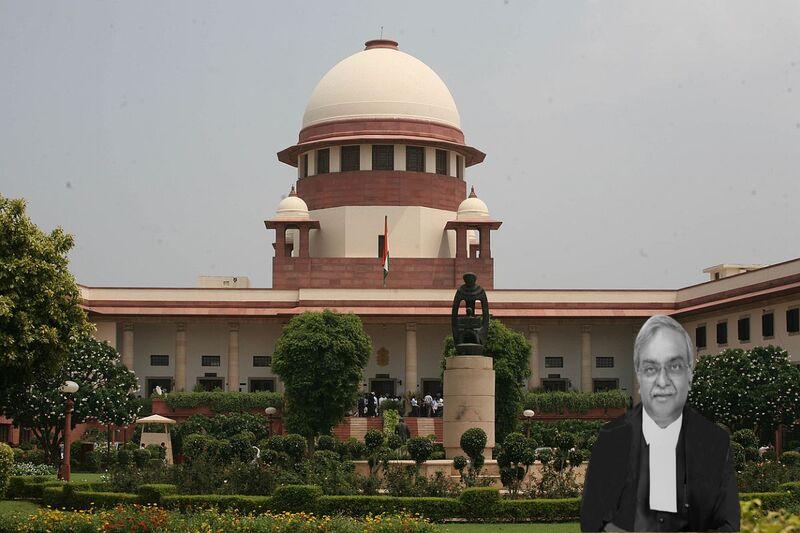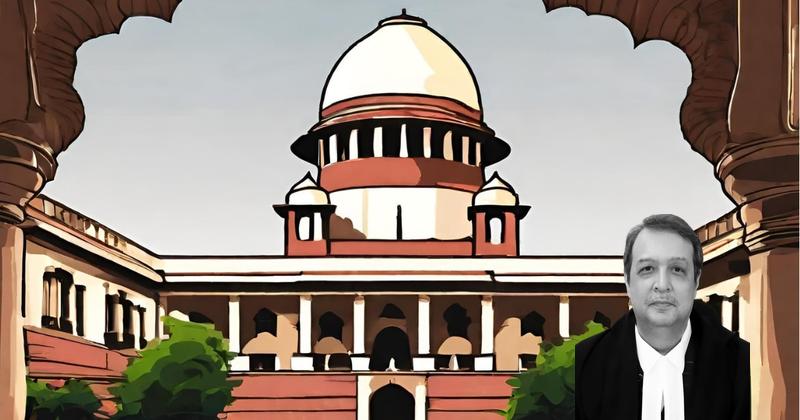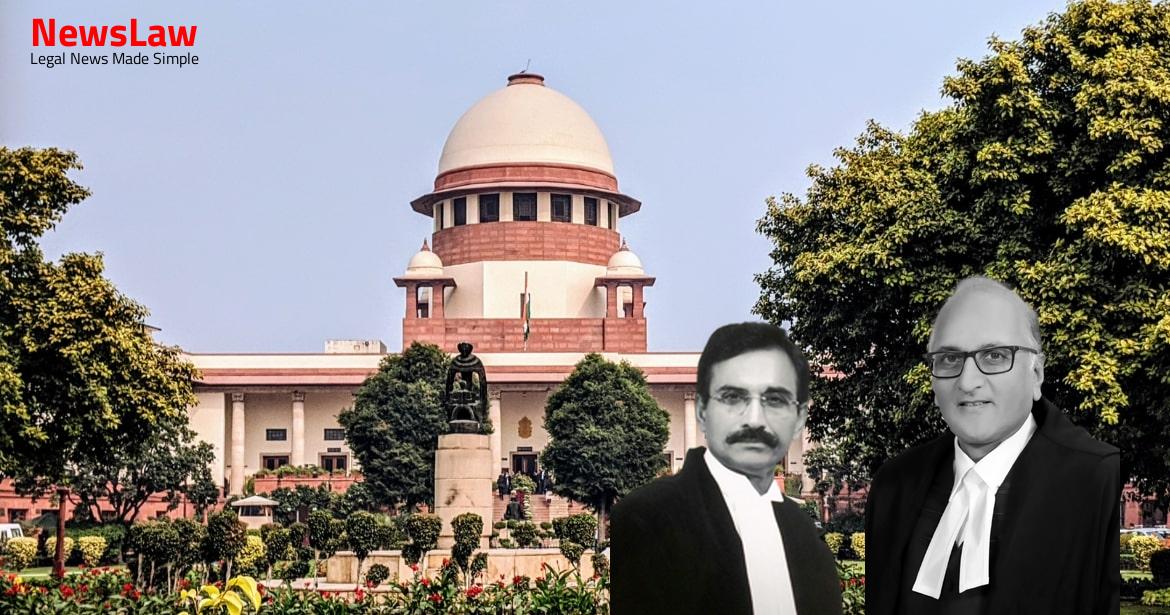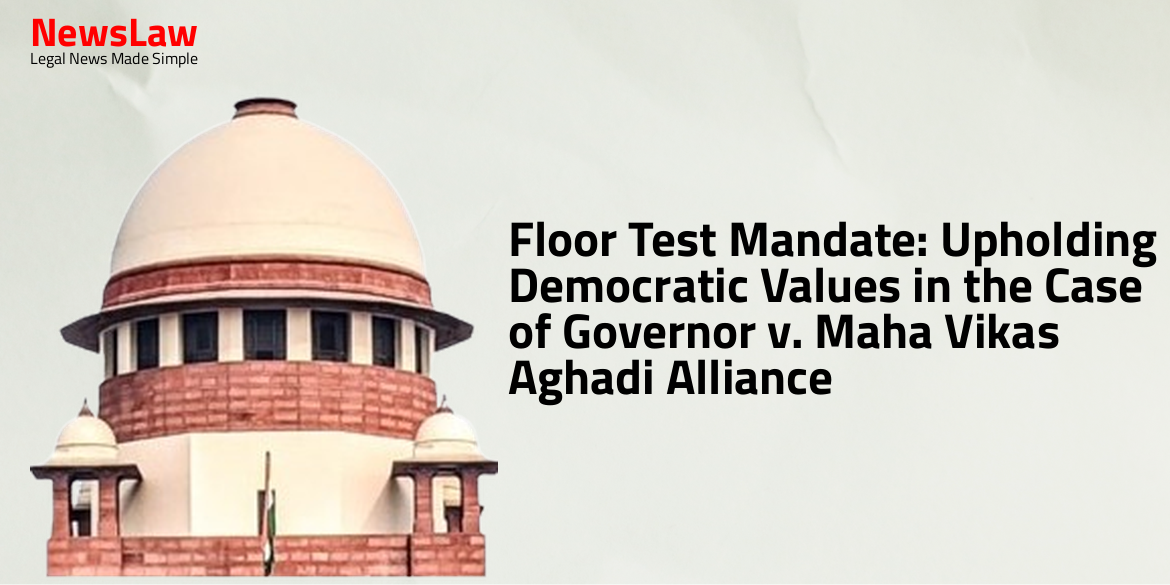The present appeal is directed against the Judgment and Order dated 14.08.2023 (hereinafter referred to as the “Impugned Judgment”) rendered by a learned Division Bench of the High Court of Jammu & Kashmir and Ladakh at Srinagar (hereinafter referred to as the “High Court”) dismissing Letters Patent Appeal No.151 of 2023 filed by the Appellants and upholding the interim order of a learned Single Judge dated 09.08.2023 in Writ Petition (Civil) No.1933 of 2023. Nataraj, learned Additional Solicitor General (hereinafter referred to as the “ASG”) for the Appellants submitted that the learned Single Judge and the learned Division Bench of the High Court have issued directions contrary to law. It was submitted 4 that both orders have been passed on an erroneous assumption that the provisions of Election Symbols (Reservation and Allotment) Order, 1968 (hereinafter referred to as the “1968 Order”), would be applicable in elections to the LAHDC. 9, 10 and 10(A) of the 1968 Order speak of restrictions on the allotment of symbols reserved for 5 State Parties in States where such parties are not recognized; concession to candidates set up by a State Party at elections in other States or Union Territories, and; concession to candidates set up by an un-recognized party which was earlier recognized as a National or State Party, respectively. Learned ASG pointed out that filing of the nomination forms had begun from 16.08.2023 and reached the penultimate stage since the last date of withdrawal of nominations (26.08.2023) had already elapsed.
It was submitted that there should not have been, in the first place, any issue with the Appellants in granting the Plough symbol for the reason that R1 is the incumbent ruling party in the LAHDC, and was entitled to the Plough symbol, since the same was neither part of the list of free symbols nor allotted to any other National or State Party, so recognized, either by the ECI or by the Election Authority for the Union Territory of Ladakh. He urged the Court to take note of the fact that despite the learned Single Judge having passed directions well before the commencement of even the filing of nominations, upheld by the learned Division Bench, which again was before the starting of the nomination process, and despite there being a contempt case pending before the learned Single Judge, which was adjourned on prayer made by the Appellants, citing the pendency of the present appeal, the Appellants had not complied with the orders of the High Court. It was submitted that a harmonious reading of Paragraphs 9, 10, 10(A) as also 12 of the 1968 Order would indicate beyond doubt that in the absence of anything to the contrary, the Appellants were required to be guided by the 1968 Order in toto, which was also the indication in the letter written by the ECI to R1 and the same view was taken by the Law Department in its Legal Opinion to the Appellants. The relevant Paragraphs of the 1968 Order, attention to which was drawn by the learned ASG and the learned counsel for R1, are set out below: “ 9. Restriction on the allotment of Symbols reserved for State parties in States where such parties are not recognised.
— If a political party, which is recognised as a State party in some State or States, sets up a candidate at an election in a constituency in any other State in which it is not a recognised State party, then such candidate may, to the exclusion of all other candidates in the constituency, be 11 allotted the symbol reserved for that party in the State or States in which it is a recognised State Party, notwithstanding that such symbol is not specified in the list of free symbols for such other State or Union territory, on the fulfilment of each of the following conditions, namely:— (a) that an application is made to the Commission by the said party for exclusive allotment of that symbol to the candidate set up by it, not later than the third day after the publication in the Official Gazette of the notification calling the election; (b) that the said candidate has made a declaration in his nomination paper that he has been set up by that party at the election and that the party has also fulfilled the requirements of clauses (b), (c), (d) and (e) of paragraph 13 read with paragraph 13A in respect of such candidate; and (c) that in the opinion of the Commission there is no reasonable ground for refusing – If a political party, which is unrecognized at present but was a recognized National or State party in any State or Union territory not earlier than six years from the date of notification of the election, sets up a candidate at an election in a constituency in any State or Union territory, whether such 12 party was earlier recognized in that State or Union territory or not, then such candidate may, to the exclusion of all other candidates in the constituency, be allotted the symbol reserved earlier for that party when it was a recognized National or State party, notwithstanding that such symbol is not specified in the list of free symbols for such State or Union territory, on the fulfillment of each of the following conditions, namely:–– (a) that an application is made to the Commission by the said party for the exclusive allotment of that symbol to the candidate set up by it, not later than the third day after the publication in the Official Gazette of the notification calling the election; (b) that the said candidate has made a declaration in his nomination paper that he has been set up by that party at the election and that the party has also fulfilled the requirements of clauses (b), (c), (d) and (e) of paragraph 13 read with paragraph 13 —(1) Any candidate at 13 an election in a constituency in any State or Union territory, other than— (a) a candidate set up by a National Party; or (b) a candidate set up by a political party which is a State Party in that State; or (c) a candidate referred to in paragraph 10 or paragraph 10A; shall choose, and shall be allotted, in accordance with the provisions hereafter set out in this paragraph, one of the symbols specified as free symbols for that State or Union territory by notification under paragraph 17. (3) Where the same free symbol has been chosen by several candidates at such election, then— (a) if of those several candidates, only one is a candidate set up by an unrecognised political party and all the rest are independent candidates, the returning officer shall allot that free symbol to the candidate set up by the unrecognised political party, and to no one else; and, if, those several candidates, two or more are set up by different unrecognised political parties and the rest are independent candidates, the returning officer shall decide by lot to which of the two or more candidates set up by the different unrecognised political parties that free symbol shall be allotted, and allot that free symbol to the candidate on whom the lot falls, and to no one else: Provided that where of the two or more such candidates set up by such different 14 unrecognized political parties, only one is, or was, immediately before such election, a sitting member of the House of the People, or, as the case may be, of the Legislative Assembly (irrespective of the fact as to whether he was allotted that free symbol or any other symbol at the previous election when he was chosen as such member), the returning officer shall allot that free symbol to that
– (1) No election shall be called in question except by an election petition presented in such 15 manner as may be prescribed and before such authority as may be appointed by Government, from time to time, by notification in the Government Gazette: Provided that no person below the rank of a District Judge shall be appointed for the purpose of this section. (3) At the conclusion of the trial of an election petition the authority appointed under sub-section (1) shall make an order– (a) dismissing the election petition; or (b) declaring the election of all or any of the returned candidates to be void; or (c) declaring the election of all or any of the returned candidates to be void and the petitioner or any other candidates to have been duly elected. – The procedure provided in the Code of Civil Procedure, Samvat 1977 in regard to suits shall be followed by the authority appointed under section 12 as far as it can be made 17 applicable in the trial and disposal of an election petition under this Act. v Union of India, (1980) 3 SCC 625 ; L Chandra Kumar v Union of India, (1997) 3 SCC 261 and more recently, to Kalpana Mehta v Union of India, (2018) 7 SCC 1 and Rojer Mathew v South Indian Bank Limited, (2020) 6 SCC 1, all of which were rendered by a Bench of 5 or more learned Judges. Even on the anvil of Krishan Industries v State of Himachal Pradesh, (2021) 6 SCC 771, Section 13 of the 1997 Act does not, and cannot, impede a Constitutional Court from proceeding further. The nature and scope of judicial review has been succinctly stated in Union of India v. The search for solutions responsive to a changed social era involves a search not only among competing propositions of law, or competing versions of a legal proposition, or the modalities of an indeterminacy such as “fairness” or “reasonableness”, but also among propositions from outside the ruling law, corresponding to the empirical knowledge or accepted values of present time and place, relevant to the dispensing of justice within the new parameters.” The aforesaid two passages lay immense responsibility on the Court pertaining to the exercise of the power keeping in view the accepted values of the present. The conferment of the power of judicial review has a great sanctity as the constitutional court has the power to 21 declare any law as unconstitutional if there is lack of competence of the legislature keeping in view the field of legislation as provided in the Constitution or if a provision contravenes or runs counter to any interpretative rights or any constitutional provision or if a provision is manifestly arbitrary. In this regard, a reference to a three-Judge Bench decision in Suresh Seth v. Repelling the submission, the Court held that it is purely a matter of policy which is for the elected representatives of the people to decide and no directions can be issued by the Court in this regard.
Union of India, (1989) 4 SCC 187 : 1989 SCC (L&S) 569] wherein it was held that no court can direct a legislature to enact a particular law and similarly when an executive authority exercises a legislative power by way of a subordinate legislation pursuant to the delegated authority of a legislature, such executive authority cannot be asked to enact a law which it has been empowered to do under the delegated authority. Krishnamurthy, (2015) 2 SCC 796 : (2015) 1 SCC (L&S) 589], the Court, after referring to Premium Granites v. State of T.N., (1994) 2 SCC 691], M.P. Narmada Bachao Andolan, (2011) 7 SCC 639 : (2011) 3 SCC (Civ) 875] and State of Punjab v. Krishnamurthy, (2015) 2 SCC 796 : (2015) 1 SCC (L&S) 589], SCC p. The constitutional courts cannot sit in oblivion when fundamental rights of individuals are at stake. When we say so, it may not be understood that while interpreting fundamental rights, the constitutional courts should altogether depart from the doctrine of precedents but it is the obligation of the constitutional courts to act as sentinel on the qui vive to ardently guard the fundamental rights of individuals bestowed upon by the Constitution. Such an approach applies with more zeal in case of Article 32 of the Constitution which has been described by Dr B.R. Article 32 enjoys special status and, therefore, it is incumbent upon this Court, in matters under Article 32, to adopt a progressive attitude.
The learned ASG also submitted that the Appellants were entitled to take an independent decision. In High Court of Tripura v Tirtha Sarathi Mukherjee, (2019) 16 SCC 663, this Court had answered, in the affirmative, as to the power of the High Courts under Article 226 to direct for actions, in 27 a rare and exceptional situation, which do not find mention in the provisions concerned. Noticing and relying upon High Court of Tripura ( supra ), in Aish Mohammad v State of Haryana, 2023 SCC OnLine SC 736, we held: “ 24.
The wide power under Article 226 may continue to be available even though there is no provision for re-valuation in a situation where a candidate despite having giving correct answer and about which there cannot be even the slightest manner of doubt, he is treated as having given the wrong answer and consequently the candidate is found disentitled to any marks. Should the second circumstance be demonstrated to be present before the writ court, can the writ court become helpless despite the vast reservoir of power which it possesses? The ECI stated that as there is no Legislative Assembly in the Union Territory of Ladakh and the 1968 Order does not provide for recognition to parties in a Union Territory without a Legislative 30 Assembly, R1 could not be recognised in the Union Territory of Ladakh.
On 31.05.2023, R1 made a representation to the Appellant No.2 seeking recognition as a State Party and for the allotment of the Plough symbol to it for all elections in the Union Territory of Ladakh. Then, the Election Department of the Union Territory of Ladakh issued a Notification on 26.07.2023 notifying the list of reserved and free symbols, in terms of the ECI’s Notification dated 15.05.2023. Upon bifurcation of the erstwhile State of Jammu and Kashmir and the creation of two new Union Territories, namely the Union Territory of Jammu and Kashmir and the Union Territory of Ladakh, though the ECI had not notified R1 as a State Party for the Union Territory of Ladakh, it cannot be simpliciter that R1 was not entitled for the allotment of plough symbol to it, in the factual background. In the present case, there is no conflict with any other stakeholder for the reason that the Plough symbol is neither a symbol exclusively allotted to any National or State Party nor one of the symbols shown in the list of free symbols. Another major issue canvassed by the learned ASG on behalf of the Appellants, to the effect that no relief be granted to R1 due to the election process 35 having reached the penultimate stage, unfortunately, has also to be noted to be rejected.
The Court would categorically emphasize that no litigant should have even an iota of doubt or an impression (rather, a misimpression) that just because of systemic delay or the matter not being taken up by the Courts resulting in efflux of time the cause would be defeated, and the Court would be rendered helpless to ensure justice to the party concerned. Shafi [(2007) 14 SCC 544 : (2009) 1 SCC (Cri) 889 : (2007) 4 SCR 1023 : (2007) 5 Scale 611] has been doubted by another Bench, the same would not mean 37 that we should wait for the decision of the larger Bench, particularly when the same instead of assisting the appellants runs counter to their contention. State of Punjab, (2009) 13 SCC 608: (2010) 1 SCC (Cri) 1135], the pendency of a reference to a larger Bench, does not mean that all other proceedings involving the same issue would remain stayed till a decision was rendered in the reference.
Insofar as the cases pending in this Court are concerned, we request the Benches concerned dealing with similar matters to defer the hearing until a decision is rendered one way or the other on the issue whether the matter should be referred to a larger Bench or not. We have also come across examples of High Courts refusing deference to judgments of this Court on the score that a later Coordinate 39 Bench has doubted its correctness. The High Courts, of course, will do so with careful regard to the facts and circumstances of the case before it. Apart from the judgments expressly considered and dealt with, hereinbefore and hereinafter, we have perused, out of our own volition, the decisions, inter alia, of varying Bench-strength of this Court in N P Ponnuswami v Returning Officer, Namakkal Constituency, 1952 SCR 218 ; Durga Shankar Mehta v Thakur Raghuraj Singh, (1955) 1 SCR 267 ; Hari Vishnu Kamath v Syed Ahmad Ishaque, (1955) 1 SCR 1104 ; Narayan Bhaskar Khare (Dr) v Election Commission of India, 1957 SCR 1081 ; Mohinder Singh Gill v Chief Election Commissioner, (1978) 1 SCC 405 ; Lakshmi Charan Sen v A K M Hassan Uzzaman, (1985) 4 SCC 689 ; Indrajit Barua v Election Commission of India, (1985) 4 SCC 722 ; Election Commission of India v Shivaji, (1988) 1 SCC 277 ; Digvijay Mote v Union of 41 India Collector, (1993) 4 SCC 175 ; Boddula Krishnaiah v State Election Commissioner, Andhra Pradesh, (1996) 3 SCC 416 ; Anugrah Narain Singh v State of Uttar Pradesh, (1996) 6 SCC 303 ; Election We would indicate that the restraint, self-imposed, by the Courts as a general principle, laid out in some detail in some of the decisions supra, in election matters to the extent that once a notification is issued and the election process starts, the Constitutional Courts, under normal circumstances are loath to interfere, is not a contentious issue. The stark factor which stares us in the face is that well before and well in time, by way of the writ petition, R1 had approached the Court of first instance (the learned Single Judge), for the reliefs, which have been found due to them ultimately, and upheld by the Appellate Court (the learned Division Bench).
However, conduct by authorities as exhibited herein may seriously compel the Court to have a comprehensive re-think, as to whether the self- imposed restrictions may need a more liberal interpretation, to ensure that justice is not only done but also seen to be done, and done in time to nip in the bud any attempted misadventure. With a sense of anguish, it would not be wrong to say that the instant judgment has been invited upon themselves by the Appellants. Apart from this, just as people develop a sense of honour, glory and patriotic pride for a flag of one’s country, similarly great fervour and emotions are generated for a symbol representing a political party. We say so because the efficacy of having a common symbol for a political group has been underscored in Sadiq Ali v. Election Commissionof India [Sadiq Ali v. Election Commission of India, (1972) 4 SCC 664], p.
48 The paragraph is designed to ensure that because of a dispute having arisen in a political party between two or more groups, the entire scheme of the Symbols Order relating to the allotment of a symbol reserved for the political party is not set at naught.
Case Title: UNION TERRITORY OF LADAKH & ORS. Vs. JAMMU AND KASHMIR NATIONAL CONFERENCE & ANR.
Case Number: CIVIL APPEAL No. 5707 OF 2023 (@ SPECIAL LEAVE PETITION (CIVIL) NO.18727 OF 2023) (2023INSC804)



